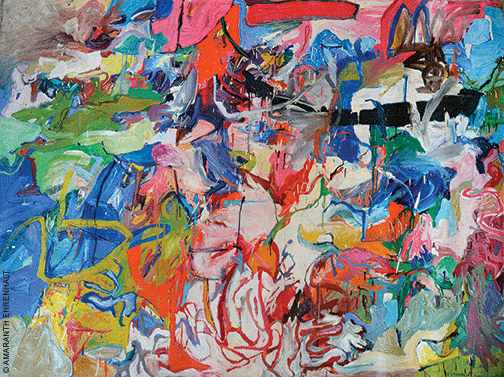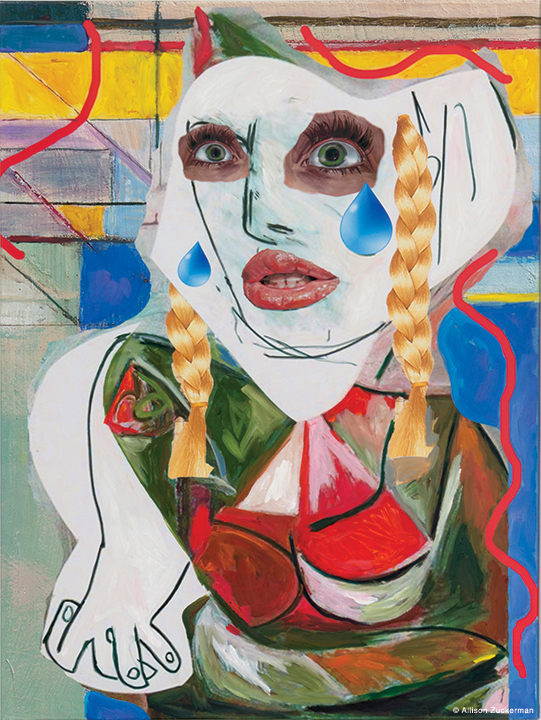
Half a century ago, when the poet John Ashbery was writing art reviews for the International Herald Tribune, his eye landed on the work of a young painter named Amaranth Ehrenhalt FA’51.
Assessing a group exhibition in Paris, he wrote: “A key figure among these 31 artists from 14 different countries might be the American Ehrenhalt, who shows a large canvas with the inviting title ‘Jump in and Move Around.’ It is both an excellent example of New York School abstraction (lush colors, fluent brushwork, bustling composition) and an attempt at a new possibly eerie form of figuration. The large flat areas juxtaposed with smaller, detailed ones seem always on the point of resolving themselves into a landscape or a portrait.”
Ehrenhalt still has that 1962 review and, on the phone from her Manhattan home 50 years later, she reads it with obvious pride. She also makes it clear that Ashbery is only one of the famous creatives whose lives have intersected with hers. She’s had drinks with Willem de Kooning, shopping trips with Alberto Giacometti, heart-to-hearts with Pegeen Guggenheim.
While she’s quite happy to recall those famous connections—and even wrote a bold-name-heavy article about them in Vogue last fall—she tells her solo story with equal zest. It starts with an early devotion to art, moves on to her decades in Paris with prominent friends, discusses her numerous exhibitions, and examines her distinctive status as one of the few living abstract expressionists from the 1950s. (Her work was recently included in the book American Abstract and Figurative Expressionism: Style is Timely Art is Timeless.)
Growing up in Philadelphia, her thoughts were far from Paris—but not from the art world. At age four, when her uncle asked what she’d like as a birthday gift, little Ehrenhalt didn’t hesitate: “Paints!”
“I was drawing and painting all the time,” she explains. “That was the only thing I was interested in. I was not interested in dolls.”
By the time she turned 12, her talent was starting to attract notice. Her teacher suggested she join a Saturday-morning program at the Philadelphia Museum of Art. While those three hours were enriching, they weren’t enough for Ehrenhalt.
“We studied art and then all the children went home except me,” she says. “I told my parents they couldn’t pick me up until the museum closed, which was around 6. What I did during those six hours would probably be very dangerous today: I wandered around by myself studying the great paintings and saying to myself, ‘Someday, when I grow up, I’ll be doing big, beautiful paintings like that.’”
She started classes at Fleisher Art Memorial a few years later. “You had to be an adult to go to adult evening classes because they had nude models there,” she recalls, “so I lied. So did my girlfriend in the neighborhood. We’d leave the house and put on our mothers’ lipstick, change our hairstyles, do anything to make ourselves look older. Sometimes some of the fellows in the class would ask if we’d like to join them for beer afterward. We’d go and they’d drink beer and we’d have a Coke. We invented stories about how we each had a fiancé.”
Even as a teenager, Ehrenhalt realized that “an artist sees more than the average person sees.” There was the time she went shopping with a friend and found herself fascinated by a salesperson’s different-colored eyes, unable to think about anything else for the next half-hour. Or when she went out on a group date and was more interested in watching strangers across the street than in flirting.
“We were stopped at a red light and I saw three little boys, with adults following them, crossing the street. The children were all wearing hats made from the Philadelphia Inquirer Sunday comics, and I got so excited because esthetically, it turned me on completely—the shapes of these little people with these colored paper hats on. I said to my friends, ‘Look! You’ve got to see this!’ My date looked at me and said, ‘Stop acting like such a child.’ And I said to myself, ‘This is the wrong man for me.’ There was something about that scene that moved me tremendously. If I were a filmmaker, I would put that in a movie.”
Ehrenhalt won a scholarship to the Pennsylvania Academy of the Fine Arts after high school and, in addition to her classes there, studied French, English, psychology, and art history at Penn. Her next stop was New York, then in the heyday of the abstract expressionist New York School.
They were lean times, as she recalled in the Vogue article: “In my Greenwich Village walk-up (toilet in the hall, bathtub next to the kitchen sink), I painted on the floor, not by choice a la Jackson Pollock, but for lack of a table.”
Still scraping by, she began making increasingly long trips to Paris until “one day I just stayed there.” That’s when the stuff of art historians’ dreams began: the friendships with Guggenheim and Ralph Rumney; the Beauford Delaney sightings at a local café; the travels through Morocco and Tunisia with Friedensreich Hundertwasser, who made three portraits of her.
It was also when she produced the vibrant painting that caught Ashbery’s eye, “Jump in and Move Around” (1961). She cites it as an excellent example of her work since, as the title reflects, “I do just that in my work: jump in and move around. I try to get into some very deep emotional state and then not really think on an intellectual or analytical level. If I think too much, it’s less effective than if I just start doing and put a blob on canvas. Once I put that blob on canvas, it’s almost like being in a trance, it’s almost like the painting is directing me in what to do.”
Another lively (and large) piece from around the same time, “Umatilla” (1959), will appear in an upcoming show at the Denver Art Museum. “I was thinking of waves of color being pushed around by air somehow when I painted that,” she says of the 59-by-87-inch work. “I said to myself, ‘I want this painting to be in a museum collection.’ It isn’t yet.”
Which brings up the complicated part of her story: Though her work is in collections around the world—from the Time, Inc. building in New York to the Hirshhorn Museum in Washington to the City of Paris Collection in France—Ehrenhalt never quite reached the art-world-superstar status that some of her famous friends occupy. Her show at the Anita Shapolsky Gallery in New York last year addressed that issue in the title: Amaranth Ehrenhalt: A Hidden Treasure.
“People who know my work can recognize it anywhere in the world, but there’s always some little element of surprise, something experimental,” says Ehrenhalt. “I was in many, many shows with Joan Mitchell, with Sam Francis, and art critics wrote about me where they didn’t even mention them. Now their paintings are selling for over a million dollars.”
Having recently celebrated her 85th birthday, she concedes that her “back feels 85,” but says that her “creativity, personality, and energy are still very young.” So she keeps making art—paintings, etchings, watercolors, sculptures, tapestries. As she explains on her website: “Joan Mitchell once asked me, in Paris, why I want to paint. I do not know if I ‘want to paint’ or do not ‘want to paint.’ It is just something that I do — like breathing and moving, walking and talking. I can not imagine my life without it.”
—Molly Petrilla C’06




